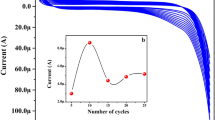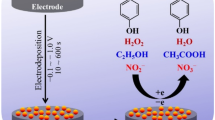Abstract
Zinc nitroprusside (ZnNP) nanoparticles were fabricated at the surface of zinc powder-doped carbon ceramic electrode (CCE) by a chemical derivatization process. This modified electrode was characterized by scanning electron microscopy, atomic force microscopy and cyclic voltammetry techniques. The charge transfer rate constant (k s) and charge transfer coefficient (α) were calculated for the electron exchange reaction of the ZnNP thin film. The ZnNP nanoparticle-modified CCE (ZnNP|CCE) showed good electrocatalytic activity toward hydrazine oxidation. The limit of detection (S/N = 3) and sensitivity were found to be 0.16 µM and 0.21 µA/µM, respectively. The mechanism of hydrazine electrooxidation at the electrode surface was studied. Finally, the ZnNP|CCE was successfully used for the determination of trace amount of hydrazine in different spiked and real samples.





Similar content being viewed by others
References
S. Garrod, M.E. Bollard, A.W. Nicholls, S.C. Connor, J. Connelly, J.K. Nicholson, E. Holmes, Integrated metabonomic analysis of the multiorgan effects of hydrazine toxicity in the rat. Chem. Res. Toxicol. 18, 115–122 (2005)
K. Yamada, K. Yasuda, N. Fujiwara, Z. Siroma, H. Tanaka, Y. Miyazaki, T. Kobayashi, Potential application of anion-exchange membrane for hydrazine fuel cell electrolyte. Electrochem. Commun. 5, 892–896 (2003)
S. Amlathe, V.K. Gupta, Spectrophotometric determination of trace amounts of hydrazine in polluted water. Analyst 113, 1481–1483 (1988)
J.W. Mo, B. Ogorevc, X. Zhang, B. Pihlar, Cobalt and copper hexacyanoferrate modified carbon fiber microelectrode as an all-solid potentiometric microsensor for hydrazine. Electroanalysis 12, 48–54 (2000)
T. Sakamoto, K. Asazawa, U. Martinez, B. Halev, T. Suzuki, S. Arai, D. Matsumur, Y. Nishihata, P. Atanassov, H. Tanaka, Electrooxidation of hydrazine hydrate using Ni–La catalyst for anion exchange membrane fuel cells. J. Power Sources 234, 252–259 (2013)
H.F. Mark, D.F. Othmer, C.G. Overberger, G.T. Seaborg, Kirk-Othmer Encyclopedia of Chemical Technology, vol. 12 (Wiley, New York, 2005), p. 734
E.H. Vernot, J.D. MacEwen, R.H. Bruner, C.C. Haun, E.R. Kinkead, D.E. Prentice, A. Hall, R.E. Schmidt, R.L. Eason, G.B. Hubbard, J.T. Young, Long-term inhalation toxicity of hydrazine. Fundam. Appl. Toxicol. 5, 1050–1064 (1985)
D. Steinhoff, U. Mohr, The question of carcinogenic effects of hydrazine. Exp. Pathol. 33, 133–143 (1988)
Y.Y. Liu, I. Schmeltz, D. Hoffman, Chemical studies on tobacco smoke. Quantitative analysis of hydrazine in tobacco and cigarette smoke. Anal. Chem. 46, 885–889 (1974)
R. Gilbert, R. Rioux, Ion chromatographic determination of morpholine and cyclohexylamine in aqueous solutions containing ammonia and hydrazine. Anal. Chem. 56, 106–109 (1984)
M. Shukla, A. Tiwari, N. Brahme, R.S. Kher, S.J. Dhoble, Enhancing effect of hydrazine on chemiluminescence of luminol-H2O2 system. J. Appl. Spec. 80, 305–307 (2013)
E.I. Morosanova, E.A. Reznikova, A.A. Velikorodnyi, Modified xerogel-based indicator powders for determining ascorbic acid and hydrazines by solid-phase spectrophotometry and visual tests. J. Anal. Chem. 56, 173–177 (2001)
C.M. Moreno, T. Stadler, A.A. Silva, L.C.A. Barbosa, M.E.L.R. Queiroz, Determination of maleic hydrazide residues in garlic bulbs by HPLC. Talanta 89, 369–376 (2012)
B. Zhou, J. Yang, X. Jiang, Porous Mn2O3 nanorods synthesized from thermal decomposition of coordination polymer and used in hydrazine electrochemical sensing. Mat. Lett. 159, 362–365 (2015)
P. Malik, M. Srivastava, R. Verma, M. Kumar, D. Kumar, J. Singh, Nanostructured SnO2 encapsulated guar-gum hybrid nanocomposites for electrocatalytic determination of hydrazine. Mat. Sci. Eng. C 58, 432–441 (2016)
S. Ameen, M.S. Akhtar, H.S. Shin, Highly sensitive hydrazine chemical sensor fabricated by modified electrode of vertically aligned zinc oxide nanorods. Talanta 100, 377–383 (2012)
V. Mani, A.T. Ezhil Vilian, S.M. Chen, Graphene oxide dispersed carbon nanotube and iron phthalocyanine composite modified electrode for the electrocatalytic determination of hydrazine. Int. J. Electrochem. Sci. 7, 12774–12785 (2012)
Y. Liu, Y. Li, X. He, In situ synthesis of ceria nanoparticles in the ordered mesoporous carbon as a novel electrochemical sensor for the determination of hydrazine. Anal. Chim. Acta 819, 26–33 (2014)
H.J. Yang, B.P. Lu, L.P. Guo, B. Qi, Cerium hexacyanoferrate/ordered mesoporous carbon electrode and its application in electrochemical determination of hydrous hydrazine. J. Electroanal. Chem. 650, 171–175 (2011)
J. Ding, S. Zhu, T. Zhu, W. Sun, Q. Li, G. Wei, Z. Su, Hydrothermal synthesis of zinc oxide-reduced graphene oxide nanocomposites for an electrochemical hydrazine sensor. RSC Adv. 5, 22935–22942 (2015)
M.H. Pournaghi-Azar, H. Nahalparvari, Preparation and characterization of electrochemical and electrocatalytic behavior of a zinc pentacyanonitrosylferrate film-modified glassy carbon electrode. J. Electroanal. Chem. 583, 307–317 (2005)
H. Razmi, E. Habibi, Nanomolar detection of hydrogen peroxide at a new polynuclear cluster of tin pentacyanonitrosylferrate nanoparticle-modified carbon ceramic electrode. Anal. Biochem. 392, 126–132 (2009)
H. Razmi, E. Habibi, Preparation and characterization of a tin pentacyanonitrosylferrate-modified carbon ceramic electrode: application to electrocatalytic oxidation and amperometric detection of l-cysteine. Electroanalysis 21, 867–874 (2009)
E. Laviron, General expression of the linear potential sweep voltammogram in the case of diffusionless electrochemical systems. J. Electroanal. Chem. 101, 19–28 (1979)
S.M. Golabi, M. Jalil, Electrocatalytic oxidation of hydrazine at epinephrine modified glassy carbon electrode (EPMGCE). Iran J. Chem. Chem. Eng. 22, 43–54 (2003)
A.J. Bard, L.R. Faulkner, Electrochemical Methods: Fundamentals and Applications (Wiley, New York, 2001)
F. Pariente, E. Lorenzo, F. Tobalina, H.D. Abruna, Aldehyde biosensor based on the determination of NADH enzymically generated by aldehyde dehydrogenase. Anal. Chem. 67, 3936–3944 (1995)
H. Ahmar, S. Keshipour, H. Hosseini, A.R. Fakhari, A. shaabani, A. Bagheri, Electrocatalytic oxidation of hydrazine at glassy carbon electrode modified with ethylenediamine cellulose immobilized palladium nanoparticles. J. Electroanal. Chem. 690, 96–103 (2013)
M.F. Wang, C. Wang, G.F. Wang, W. Zhang, F. Bin, Electroanalysis 22, 1123 (2010)
G. Wang, C. Zhang, X. He, Z. Li, X. Zhang, L. Wang, B. Fang, Detection of hydrazine based on nano-Au deposited on porous-TiO2 film. Electrochim. Acta 55, 7204–7210 (2010)
B. Fang, C.H. Zhang, W. Zhang, G.F. Wang, A novel hydrazine electrochemical sensor based on a carbon nanotube-wired ZnO nanoflower-modified electrode. Electrochim. Acta 55, 178–182 (2009)
J. Zheng, Q. Sheng, L. Li, Y. Shen, Bismuth hexacyanoferrate-modified carbon ceramic electrodes prepared by electrochemical deposition and its electrocatalytic activity towards oxidation of hydrazine. J. Electroanal. Chem. 611, 155–161 (2007)
D. Jayasri, S.S. Narayanan, Amperometric determination of hydrazine at manganese hexacyanoferrate modified graphite–wax composite electrode. J. Hazard. Mater. 144, 348–354 (2007)
C. Zhang, G. Wang, Y. Ji, M. Liu, Y. Feng, Z. Zhang, B. Fang, Enhancement in analytical hydrazine based on gold nanoparticles deposited on ZnO-MWCNTs films. Sens. Actuators B 150, 247–253 (2010)
S. Mutyala, J. Mathiyarasu, Preparation of graphene nanoflakes and its application for detection of hydrazine. Sens. Actuators B 210, 692–699 (2015)
A. Ejaz, M.S. Ahmed, S. Jeon, Highly efficient benzylamine functionalized graphene supported palladium for electrocatalytic hydrazine determination. Sens. Actuators B 221, 1256–1263 (2015)
A. Abbaspour, A. Khajehzadeh, A. Ghaffarinejad, Electrocatalytic oxidation and determination of hydrazine on nickel hexacyanoferrate nanoparticles-modified carbon ceramic electrode. J. Electroanal. Chem. 631, 52–57 (2009)
H. Razmi, A. Azadbakht, M. Hossaini-Sadr, Application of a palladium hexacyanoferrate film-modified aluminum electrode to electrocatalytic oxidation of hydrazine. Anal. Sci. 21, 1317–1323 (2005)
Z. Zhao, Y. Sun, P. Li, W. Zhang, K. Lian, J. Hu, Y. Chen, Preparation and characterization of AuNPs/CNTs-ErGO electrochemical sensors for highly sensitive detection of hydrazine. Talanta 158, 283–291 (2016)
F.A. Harraz, A.A. Ismail, S.A. Al-Sayari, A. Al-Hajry, M.S. Al-Assiri, Highly sensitive amperometric hydrazine sensor based on novel α-Fe2O3/crosslinked polyaniline nanocomposite modified glassy carbon electrode. Sens. Actuators B 234, 573–582 (2016)
N. Miller, J.C. Miller, Statistics and chemometrics for analytical chemistry, 4th edn. (Pearson education limited, London, 2000), p. 121
Acknowledgements
We gratefully acknowledge the support of this work by Nanotechnology Research Center of Urmia University and Department of Chemistry Azarbaijan Shahid Madani University.
Author information
Authors and Affiliations
Corresponding author
Rights and permissions
About this article
Cite this article
Habibi, E., Heidari, H. High-sensitive amperometric hydrazine sensor based on chemically synthesized zinc nitroprusside nanoparticle-supported carbon ceramic electrode. J IRAN CHEM SOC 14, 1301–1308 (2017). https://doi.org/10.1007/s13738-017-1080-6
Received:
Accepted:
Published:
Issue Date:
DOI: https://doi.org/10.1007/s13738-017-1080-6




